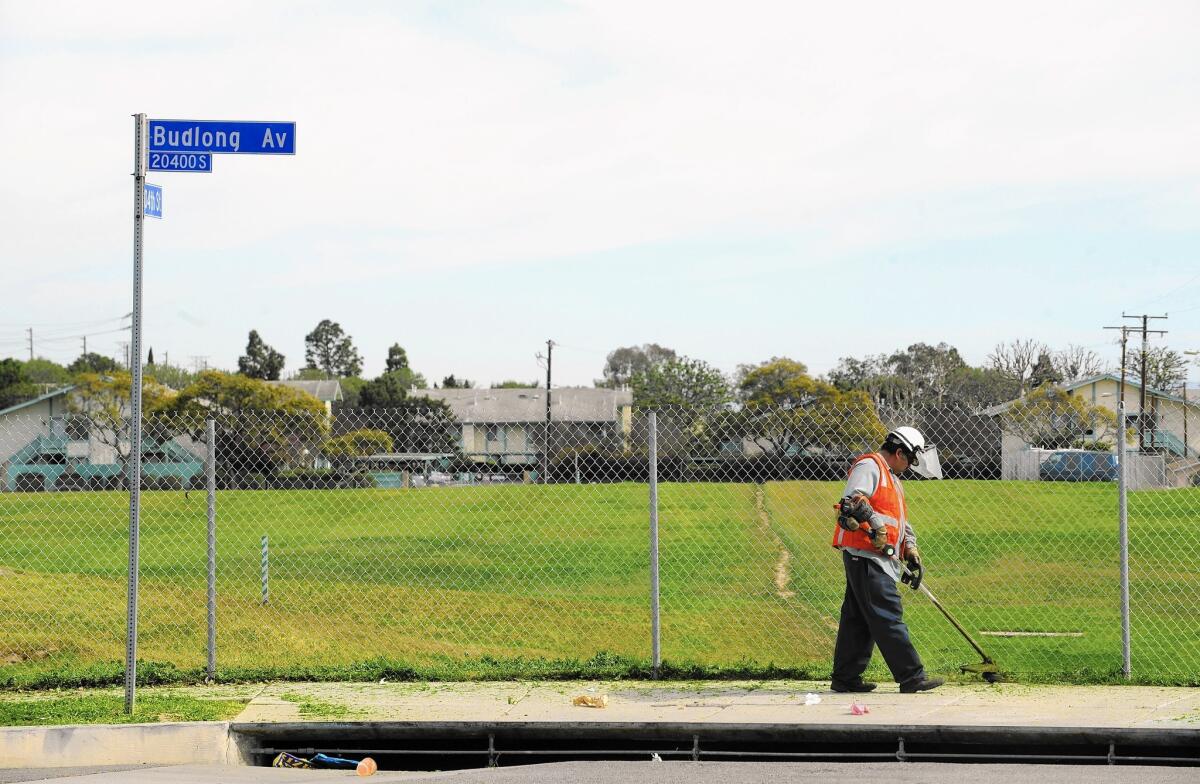EPA begins testing air in homes near South Bay Superfund sites

Nearly 15 years after crews dug up and replaced contaminated soil from Cynthia Medina’s frontyard, federal officials have placed dart-sized air quality samplers in her South Bay home. The tests will reveal whether dangerous vapors are seeping inside from polluted groundwater below her house.
The U.S. Environmental Protection Agency last month began testing the air inside dozens of homes near two of the nation’s worst chemical dumping sites for trichloroethylene, benzene and chlorobenzene. They were prompted by worries that, through a process known as vapor intrusion, the pollutants could be evaporating through the soil and into homes and putting residents at risk.
Medina and other residents and community activists have pleaded with the EPA in recent years to test their homes for soil vapors. Their demands followed decades of discoveries of contaminated soil and groundwater in the unincorporated community near Torrance, the legacy of decades of chemical dumping at the former Montrose Chemical Corp. DDT plant, at the Del Amo synthetic rubber plant and at other industrial operations that closed years ago.
Federal officials now agree that indoor air quality tests are urgently needed. They cite recent scientific studies that show breathing trichloroethylene, or TCE, an industrial solvent often used in the area, poses more serious health risks, including cancer and birth defects, than previously thought.
“We hope this will answer a lot of questions about this community and whether it’s really safe to live here,” said Medina, a 30-year resident and a member of the Del Amo Action Committee, a neighborhood group.
Medina, 59, raised her four children in this working-class community of a few hundred homes. She worries her family’s health has suffered from chemicals in the soil and in a plume of contaminated groundwater about 50 feet below the surface.
Montrose manufactured DDT at its 13-acre plant from 1947 to 1982, dumping the since-banned pesticide and chlorobenzene, a raw ingredient used to make it, into ponds and trenches and into the ground and aquifers below. The facility also released chemicals into stormwater channels, the sewer system and the Pacific Ocean. In 1989, the EPA added the Montrose plant to its list of Superfund sites under the 1980 federal law that aimed to clean the nation’s most hazardous dumping grounds.
At the Del Amo site, a large industrial complex built during World War II, benzene was used to make synthetic rubber, and the chemical waste was dumped in unlined pits and evaporation ponds. The U.S. government sold the 280-acre site to Shell Oil Co. in the 1950s, and it was listed as a Superfund site in 2002.
TCE in the groundwater also migrated to the area from other industrial facilities nearby, including a Boeing machine shop, federal officials said.
In addition to the two South Bay sites, federal officials are investigating vapor intrusion at 18 other of the 97 Superfund sites in California. Several are in Silicon Valley, where companies used TCE to make computer semiconductors, and in Southern California, where the aerospace industry used the compound as a metal degreaser, the EPA said.
The EPA has spent $48 million cleaning and containing chemical waste at the South Bay sites and recovered about $31 million from the parties found responsible. The agency has set aside $550,000 for the vapor intrusion testing in the neighborhood and expects to have results within a few months.
Given the history of contamination in the area, Medina said, she doesn’t understand why the EPA didn’t conduct vapor testing sooner.
EPA officials said they decided to test the air inside South Bay homes largely because of a 2011 agency assessment of TCE, which has tainted aquifers in the area and across the nation.
The review found that inhaling the chemical poses a higher cancer risk than previously thought and can cause heart defects in developing fetuses after three weeks of exposure during the first trimester of pregnancy.
A series of EPA memos last year made testing for TCE vapors a priority, prompting officials to revisit Superfund sites across the region, where the contaminant was widely used. Using new, stricter health standards, the agency is speeding up its investigations.
“The need to sample is urgent,” said John Lyons, acting assistant director of the EPA’s regional Superfund division.
Another factor that led to air quality testing at the South Bay cleanup sites is data showing polluted groundwater has grown shallower and closer to residents, EPA officials said. Of even greater concern was the recent discovery that levels of TCE and other contaminants are increasing below some homes.
Titus Marumoto lives next to a monitoring well on West 204th Street, where EPA officials have detected an increase in groundwater pollution levels over the last two to three years.
Marumoto, a 52-year-old carpenter who grew up in the neighborhood, recently moved back to his deceased parents’ house. He wants to fix up the place, but he won’t do so until he learns the test results.
“I have my 7-year-old granddaughter who lives here, so I want to know if it’s healthy for her to be raised in this environment,” Marumoto said.
The EPA is offering air quality testing to about 350 homes in the neighborhood. So far, a few dozen have agreed to the sampling.
The agency is testing during winter because people tend to leave their windows closed, making it easier to detect vapors that might be building up inside the homes or in crawl spaces.
If the testing detects concentrations of TCE above 2 micrograms per cubic meter, under EPA guidelines the agency should act to reduce health risks in a matter of weeks. That could include increasing ventilation, installing air purifiers, sealing cracks in the home or installing devices below ground to redirect vapors, officials said. Levels above 6 micrograms per cubic meter would require immediate measures, or even the temporary relocation of residents.
It’s not the first time residents near the Del Amo and Montrose sites have faced the prospect of leaving their homes because of contamination. In the 1990s, Shell bought and demolished 63 homes in the neighborhood after bowling ball-sized chunks of DDT were found in the soil. In 2001, crews removed DDT-laced soil from the frontyards of 24 homes along South Kenwood Avenue, where an open ditch had for decades carried drainage water from the Montrose plant.
Back then, Medina joined her neighbors in putting up signs with the plea “Buy Us Out.”
Her worries have only grown since then. Although she said she has no proof, Medina believes that chemicals from the Superfund sites are tied to cancer, miscarriages and other health problems in the community. She has voiced her concerns at community meetings, amassed grocery bags full of documents and sent postcards to the EPA demanding action.
“I don’t have the means of moving,” Medina said. “There are a lot of people in our situation, and that’s sad.”
Meanwhile, under a consent decree with state and federal regulators, Montrose in December finished building a $22-million water treatment plant to extract and clean contaminated groundwater in the area and inject it back into the aquifer. But the system has not been turned on because of concerns Medina and other members of the Del Amo Action Committee have raised about whether the treated water is clean enough to re-inject.
In a written statement, Montrose said “the treatment system will reduce the size of the groundwater plume and help pull it away from residential areas. Montrose wants to avoid vapor intrusion concerns arising out of the levels of chemicals in the groundwater, and believes that operation of the treatment system should begin immediately.”
[email protected]
Twitter: @tonybarboza







